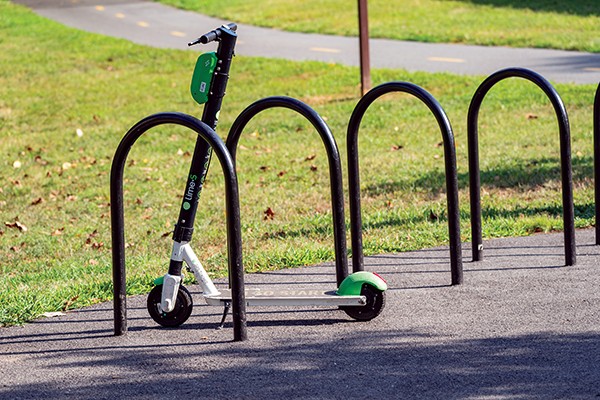Driving down North Watkins/Cleveland Street, I fumbled as the four-lane road turned into two to make way for the bike lanes. I’ve driven down this road many times since the lanes were repainted following all the redevelopment in and around the old Sears building, but, somehow, I still manage to forget that the right lane ends.
My friend Diana is riding along in the passenger seat. As we pass the fleet of bicycles and electric scooters parked around the Concourse, she says, “If people were just given free bikes, I think they would use them more.” I look back at the scooters and imagine a world where everyone has a bicycle. Would we even have the fleets of e-scooters in our city?
When the scooter companies were setting up shop in Memphis, I remember one of the biggest selling points was that these scooters would be the solution to the first/last mile problem. The first/last mile refers to the “getting to the door” parts of a commute that a bus or car can’t get you to. Scooters are for short-distance trips to fill these gaps.
 Mkopka | Dreamstime.com
Mkopka | Dreamstime.com
A closer ride with thee?
We now have at least four options to choose from: Bird, Spin, Bolt, and the recently released OjO seated-scooters that operate through Explore Bike Share. Lime pulled its scooters from the streets in October, and although they didn’t provide concrete reasons for the move, they did mention that in the winter, the size of Lime’s fleet can’t compete.
The companies promoted that the scooters are here to help folks make their connections. When the Bolt Chariot scooters came in, they claimed that addressing transportation needs and gaps of “under-served neighborhoods where there isn’t transportation or infrastructure to the interior” is part of the company’s philosophy. Ideally, this would mean connecting people from where they are to public transit (i.e. the closest bus line, train, subway). This could work in cities with more robust and well-funded public transit, but in Memphis, where we have an under-funded bus system, it just doesn’t cut it.
The city’s now-permanent Shared Mobility Program, which kicked off in June after a pilot phase, is planning on expanding the fleet of micro-mobility vehicles in Memphis to 3,000. During the announcement of the program, a city spokesperson made the statement that “More options means more access.” There definitely will be more companies to pick and choose from, but these options do not necessarily mean more access. It’s actually about who has access to those options.
When you look at a map of the city and see where these scooters are located, the “who” becomes clearer to define. So, I downloaded the Bird, Bolt, and Spin apps to look at their scooter distribution. I didn’t go into Explore Bike Share because their scooters and bicycles have docking stations. I also found that the organization is more transparent about their ridership and data than the scooter companies.
A majority of the scooters are where you would expect: Downtown, Medical District, University District, and Midtown. Bolt and Spin have a handful of scooters in neighborhoods outside of this corridor but not in significant numbers compared to Downtown.
If you put the scooter locations over a map that shows the percent of workers by ZIP code who use public transportation to get to work, it aligns almost perfectly. The ZIP codes along the east to west corridor that runs in the middle of the city (the districts mentioned earlier) have significantly fewer people who are dependent on public transportation. North and south of this corridor have higher concentrations of people who depend on the buses to get to work. But you won’t find many scooters in these areas.
Scooter companies will come and go, and it’s pretty clear that they tend to stick to high-traffic tourist areas. I’m interested to see what data these companies will report back through the Shared Mobility Program. In the next year, we will hopefully have the numbers to see how many people are using the scooters and where, and we’ll also know whether or not they are using them to connect to a bus line.
If micro-mobility companies are coming in, then public mass transit must be built up along with shared-mobility options. Independent of scooters and other micro-mobility connections, we must have reliable bus lines that can get Memphians to and from work, school, and hospitals. We need public transportation that is sustainable, reliable, and truly accessible to all Memphians.
Aylen Mercado is a brown, queer, Latinx chingona and Memphian exploring race and ethnicity in the changing U.S. South.